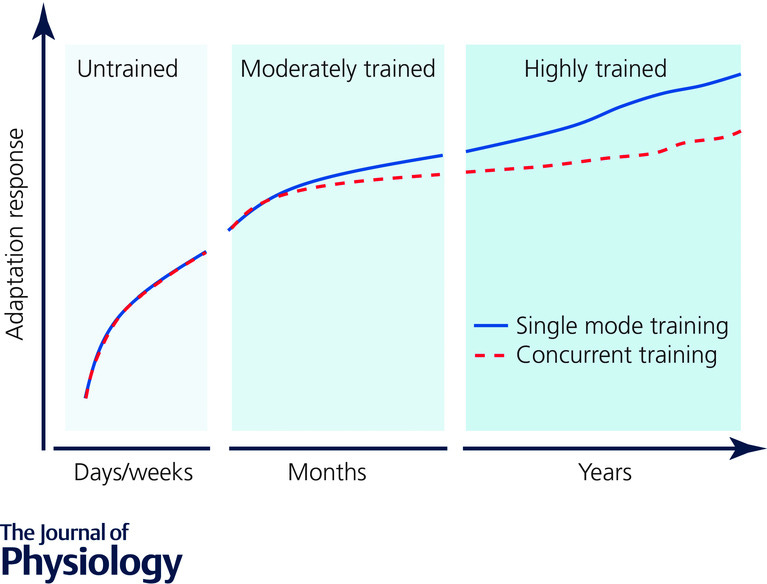The interference effect is a non-issue for most athletes
Is the interference effect only an issue for elite single-mode sport athletes?
Most Hybrid athletes don’t need to worry about the interference effect!!
I think this statement is becoming well known now but it isn’t always well explained.
So, I’m going to critique the schematic presented by Coffey & Hawley (2016) in their excellent paper “Concurrent exercise training: do opposites distract?” In the Journal of Physiology.
This schematic represents the possible magnitude of interference based on time training and level of athlete, by comparing single mode training to concurrent training performance adaptations. As you can see, the more trained you become, the greater difference in adaptation between the two training programs.
Highly trained
This make sense in highly trained athletes. This is because
They have a higher training volume and intensity, which will derive greater acute and chronic fatigue
Too much training in two sports will mean less training in the sport you’re trying to be highly trained in (we’ve only got so much time in the day to train and recover)
Once you get to the elite level too much training in one training domain may lead to negative outcomes (i.e too much weight training could lead to an increase in body weight which may negatively effect performance in an elite runner)
This last point highlights where I think the schematic needs adapting. Any large interference effect is only present in single-mode sports at the elite level. You need to be excellent in a single sport for the interference effect to have a significant negative impact on your performance.
For example, I’ve seen very good hybrid athletes achieve 5km run times between 16-18 minutes. That’s very good, but if they wanted their run times to get even faster i.e enter the elite level, then they’ll enter a level of training where the interference could be more problematic, i.e the type/intensity/volume of their strength training as a hybrid athlete could inhibit their progress to elite level in running.
Moderately trained
So, if the highly trained section is for elite athletes in their respective sports, then the moderate section more accurately represents the hybrid training population. You can train as a hybrid athlete and achieve very good run times (but not reach the elite level for running), AND you can do that while training and achieving very good numbers at a strength sport. Why?
In this section the interference effect is much smaller for two main reasons:
The interference effect can be easily reduced/manipulated by good programming. The interference effect only appears larger than it is just because your training for 2 goals as opposed to one, so your progress isn’t inhibited, it is just slower.
The physical qualities necessary to be both very fit and very strong can co-exist. Maybe not to the elite level in one specific sports, but they can co-exist to make you very good at 2 opposing sports.
This would explain why we are seeing hybrid athletes and Crossfit athletes achieving amazing results. Their performances in their chosen sports are very good, but not elite, because we can still reach the ‘very good’ level in multiple sports simultaneously. The ‘interference effect’ is not stopping them reaching the ‘very good’ level.
The Novice
The novice section of the schematic is detailed perfectly. Novice athletes respond, adapt and improve to any type of training you give them, whether it is combined or single-mode. The majority of the concurrent training literature which has used novice athletes have found no differences in performance between single-mode training and concurrent training. With the right progressive training, a novice can easily move into the moderately training section and experience minimal interference.
New schematic?
Based on these ideas I have altered the schematic. I have removed the time spent training on the X-axis and changed the headings for each of the 3 sections. To summarize:
Novice athletes adapts to anything. Interference effect is a non-issue
Hybrid athletes can achieve very good adaptations and performance results and experience minimal interference if they’re smart with their programming
It is only at the elite level of single-mode sports where the interference effect can be a bigger issue
Do you agree? Let me know in the comments
Dr Phil Price
🌐 Website - https://www.theprogresstheory.com/
📸 Instagram - https://www.instagram.com/drphilprice/?hl=en
🐦 Twitter - https://twitter.com/thepricep?lang=en
Kult Media - Innovative podcast production and content creation. Without them the show would not be possible. Thinking about starting your own podcast? head to www.kult.media.com
HMN24 - Fuelling human performance - Optimise your day by checking out their amazing supplements - Use phil10 for 10% at checkout - https://hmn24.com/
Strength Coach Nause - Download your own interactive Hybrid training programming template - 15% off using this link - https://www.strengthcoachnause.co.uk/12-week-hybrid-training-tp





